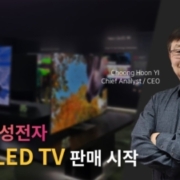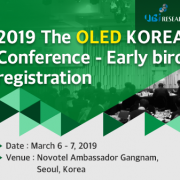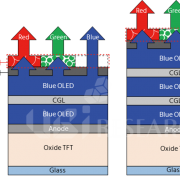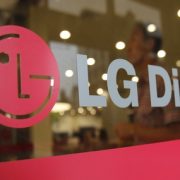글
[OLED KOREA 2019] 조기 등록 D-4 (1월31일까지)
/카테고리: Exhibition, 포커스온 /작성자: olednet2018년은 OLED 산업에서 이제까지의 응용제품 시장을 변경시키는 변곡점이 된 해이다. 2018년에새로 등장한 OLED 응용 제품으로서는 폴더블폰과 8K OLED, 롤러블 TV, 잉크젯 기술로 만든 모니터, 자동차용 사이드뷰 디스플레이 5가지이다. OLED KOREA 2019은 이들 5가지 응용제품과 관련된 기업들이 총 출동하여 2019년 시장과 기술 방향에 대해 발표한다.
[Speaker]
Samsung Display Hyein Jeong
LG Display KY(Stephen) Ko
TCL Dr. Jueng-Gil(James) Lee
JOLED Dr. Toshiaki Arai,
Boeing Dr. Julian Chang
eMagin Dr. Amal Ghosh
UBI Research Dr. Choong Hoon YI
Cynora Dr. Andreas Haldi
Merck Dr. Remi Anemian
Sumitomo Chemical Takeshi Yamada
UDC Dr. Mike Hack
Kyulux Dr. Junji Adachi
Kateeva Kyung-Bin Bae
Idemitus Kosan Jisung So
Kolon Dr. Chung-Seock Kang
3M Sun-Yong Park
Nanosys Dr. Nahyoung Kim
ETRI Dr. Hyunkoo Lee
AMAT Dr. Robert Jan Visser
OTI Dr. Michael Helander
BLUE OLED, is rapidly emerging as a competitor of WRGB OLED
/0 코멘트/카테고리: Uncategorized /작성자: OLEDNETIn the premium TV market, the share of OLED TVs is steadily increasing, and the price gap with LCD is gradually decreasing. As a result, LCD TV (QD-LCD TV) companies using quantum dot technology are sluggish in the premium TV market.
OLED TV uses white OLED and OLED panel with color filter (hereafter referred to as WRGB OLED), which is mass-produced only by LG Display.
Samsung Display is known to actively develop blue OLED + QDCF (blue OLED), which is one of the technologies to compete with WRGB OLED in the premium TV market.
UBI Research predicted that Samsung Display would implement blue OLED + QDCF with top emission method and it would be more advantageous to implement 8K and BT 2020 than WRGB in its ‘2018 OLED Material Industry Report’ published on April 18.
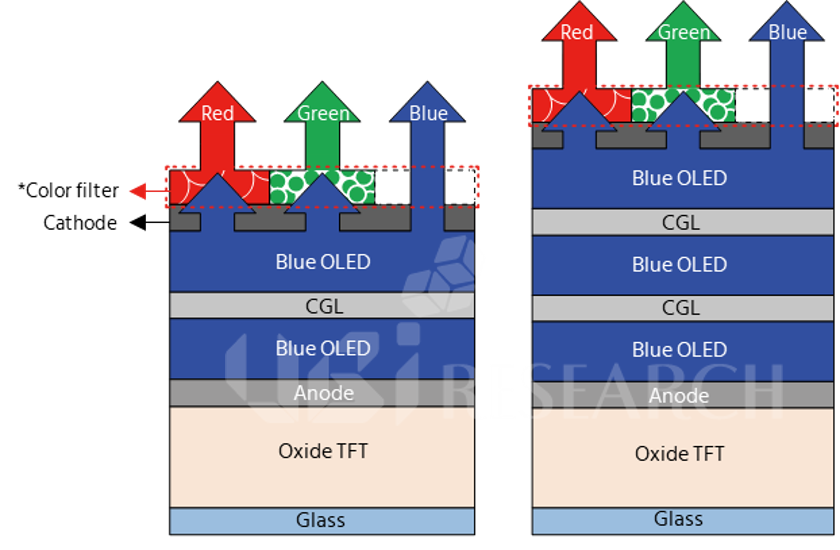
<Expected stack structure for Blue OLED, 2stack (left), 3stack (right), 2018 AMOLED emitting materials Report, UBI Research>
8K and BT2020 are to be adopted for the premium TVs. Also, the development of blue materials is expected to be aggressively progressed according to Samsung Display’s development of blue OLED. The blue material currently used in OLED is a fluorescent material that is insufficient in the efficiency and lifetime than phosphorescent material used in red and green. Blue phosphorescent materials have been developed continuously but they have not been applied to mass production due to the scarcity of materials and technical barriers. Therefore, blue fluorescent materials are stacked two or more times to improve efficiency and lifetime for large area OLED, and blue OLED is expected to use more than 2 stack structure.
With this trend, the market for blue emitting materials is expected to continue to grow. In 2017, blue materials (host and dopant) formed market of US$ 70 million. According to the 2018 AMOLED emitting material market track published by UBI Research, blue material is expected to grow at an average annual rate of 32% by 2022 and reach US $ 272 million sales.
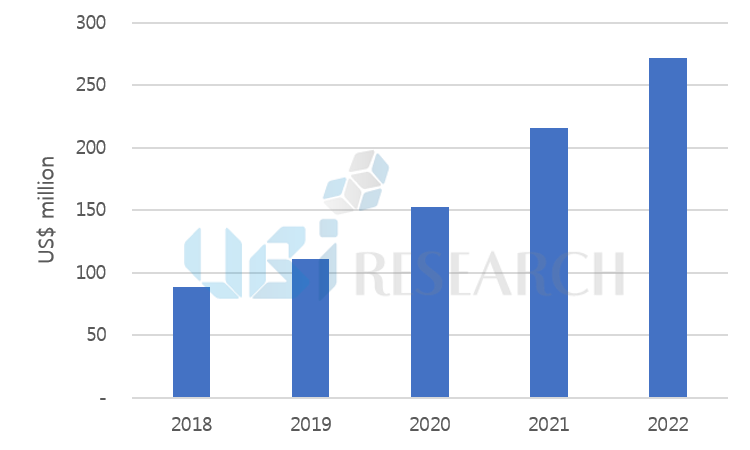
<Blue material (host and dopant) market forecast, 2018 AMOLED emitting materials Market track>
BLUE OLED, WRGB OLED의 경쟁자로 급부상
/0 코멘트/카테고리: 발광재료, 포커스온, 포커스온, 포커스온 /작성자: OLEDNET프리미엄 TV 시장에서 OLED TV의 점유율이 지속적으로 증가하고 있으며, LCD와의 가격 격차도 점차 감소하고 있는 추세로 quantum dot 기술을 적용한 LCD TV(QD-LCD TV)업체들이 프리미엄 TV시장에서 주춤하고 있는 상황이다.
OLED TV는 white OLED와 color filter를 적용한 OLED panel을 사용하고 있으며(이하 WRGB OLED) LG Display에서 유일하게 양산하고 있다.
삼성디스플레이에서는 프리미엄 TV시장에서 WRGB OLED에 대항하기 위한 기술 중 하나인 blue OLED + QDCF(이하 blue OLED)를 적극적으로 개발하고 있는 것으로 알려졌다.
유비리서치는 지난 18일 발간한 ‘2018 OLED 재료 산업 보고서’에서, 삼성디스플레이는 top emission 방식으로 blue OLED+QDCF를 구현할 것으로 예상했으며, 이에 따라 8K와 BT 2020을 구현하는데 WRGB 보다 유리할 것으로 분석한 바 있다.

<Blue OLED 예상 스택 구조, 2stack (좌), 3stack (우), 2018 AMOLED emitting materials Report, UBI Research>
TV의 트랜드가 8K, BT2020으로 진행되고 있으며, 삼성디스플레이의 blue OLED 개발에 힘입어 blue materials에 대한 개발도 적극적으로 진행될 전망이다. 현재 OLED에 사용되고 있는 blue재료는 형광물질로서 red와 green에 사용되는 인광물질보다 효율과 수명이 부족하다. Blue 인광재료 개발도 지속적으로 진행되 오고 있지만 재료의 희소성과 기술장벽으로 양산에 적용되지 못하고 있는 실정이다. 따라서 대면적 OLED panel에는 형광 blue 재료를 2번이상 적층하여 효율과 수명을 향상시키는 stack 구조를 적용하고 있으며, blue OLED도 2 stack 이상의 구조를 사용할 것으로 예상된다.
이러한 추세에 따라 blue 발광재료에 대한 시장도 지속적으로 성장할 것으로 예상된다. 2017년 blue 재료(host와 dopant)는 US$ 70 million의 시장을 기록했다. 유비리서치에서 발간한 2018 AMOLED emitting material market track에 따르면 blue 재료는 2022년 까지 연평균 32%로 성장하여 US$ 272 million의 규모가 될 것으로 전망했다.

<Blue 재료(host와 dopant) 시장전망, 2018 AMOLED emitting materials Market track>
LG Display, OLED Investment Ratio 50% this year → Next year 70%
/0 코멘트/카테고리: /작성자: OLEDNETDuring the 3Q performance conference call on 26th, LG Display mentioned that their investment ratio in OLED was 50% this year, and plans to increase its ratio to at least 70% next year.
Small and medium sized mobile display market will quickly change from LCD to POLED, and plans to strengthen business cooperation in 1Q of next year, such as mass production of 6th generation E5 line and technological competitiveness, in order to make the basis of OLED extension. It means they started to concentrate on small and medium sized OLED business starting next year.
They also revealed their production plan and future strategies of POLED production line. Gumi E5-1 line and E5-2 line are productions lines with monthly production capacity of 7500 sheets each, where they are proceeding POLED investments after converting existing LTPS facility, and also Paju E6 line is in process of investment to increase the monthly capacity of 15,000 sheets. It seems they will be capable for mass production by 2H 2018.
OLED TV market indicated that they will continue to put effort in cost reduction from improvements in rate, process, and production. They mentioned to establish OLED market more firmly in 1H of next year after successfully increasing the mass production capacity to 25,000 sheets. Among the entire TV panel, OLED sales took up 10%, and among OLED TV panel, 55-inch screen took up 70%, and they forecasted 65-inch market ratio will increase.
They noted they have high expectations of market growth in large screen HD field in large LCD. China is catching up in the market very fast but, they emphasized they will be able to easily acquire profitability by concentrating in high-end LCD such as OLED.
The biggest reason that they choice OLED as their next generation business is because there are possibilities in extension in automobile and commercial other than existing TV•monitor IT devices, and in case of automobiles, they said they are currently in cooperation with many other companies, and also informed many companies are interested in currently ongoing topic, VR, where they plan to adopt plastic OLED products.
In case of commercial products, they are proceeding developments with their customers in various fields such as medical and broadcasting other than public signage. They also mentioned that they are planning to proceed OLED light business after collecting many applications in one place.
From price increase of large LCD panel and extension of large-scale trend of all products, LG Display continued their profit relay for 18 consecutive quarters by resulting 3rd quarter sales of 6,723,800 million KRW and profit of 323,200 million KRW. Sales increased by 15% (5,855,100 million) compared to past quarter, operating profit increased by 634% compared to past quarter (44,400 million KRW) due to improvements in high-valued products such as ASP, UHD, and IPS.
On the other hand, according to Yubi industry research, LG Display forecasted to ship out 900 thousand large OLED panel in 2016, and 1,500 thousand in next year.
LG디스플레이, OLED 투자 비중 올해 50% → 내년 70%
/0 코멘트/카테고리: 시장 /작성자: OLEDNETLG디스플레이는 26일 진행된 3분기 실적 컨퍼런스콜을 통해 올해 OLED관련 투자 비중은 50%이며, 내년에는 적어도 70% 수준으로 투자비용을 늘릴 것이라고 밝혔다.
중소형 모바일 디스플레이 시장은 LCD에서 POLED로 전환이 가속화 될 것이며, 내년 상반기 6세대 E5라인 양산 안정성과 기술경쟁력을 확보하는 등 비즈니스 협력을 강화하여 OLED 확대 기반을 쌓는 원년으로 만들 것이라고 강조했다. 내년부터는 중소형 OLED 사업에 주력하기로 한 것이다.
POLED 생산라인의 생산계획과 미래전략도 밝혔다. 구미 E5-1라인과 E5-2라인은 각각 월 7500장 규모의 생산라인으로 기존 LTPS 설비를 전환해 POLED 투자를 진행하고 있으며 파주 E6라인도 월 1만5000장 규모로 투자를 진행중이다. 2018년 하반기에 양산이 가능할 것으로 밝혔다.
OLED TV 시장은 수율 및 프로세스 개선, 생산성 향상 등으로 코스트 절감 노력을 지속할 것이라고 밝혔다. 내년 상반기 8세대 2만5000장 capa를 성공적으로 양산하여 고객 다변화를 통한 OLED TV 시장을 더욱 견고히 구축할 것이라고 밝혔다. 올해 전체 TV 패널 중 OLED 매출 비중은 10%였고, OLED TV 패널 중 55인치 비중은 70%였으며, 내년에는 65인치 비중이 조금 더 증가할 것으로 예상된다고 전했다.
대형 LCD에서는 대형화 고해상도 영역에서 시장 성장의 기대감이 높다고 밝혔다. 중국의 추격이 거세지만 OLED 등 하이엔드 LCD에 집중한다면 2~3년 동안 충분히 수익성을 확보할 수 있다고 강조했다.
OLED 비즈니스를 차세대 사업으로 꼽은 가장 큰 이유는 기존 TV·모니터용 IT 기기 이외에 자동차, 커머셜용 등으로 확장성이 있으며 자동차의 경우 여러 업체와 협업을 진행 중이며 최근 화두인 VR 또한 플라스틱 OLED 제품 채택에 여러 업체가 관심을 보이고 있다고 밝혔다.
커머셜용의 경우 퍼블릭 사이니지 외에 의료용, 방송용 등 다양한 분야에서 실질적으로 고객과 개발 협업을 진행하고 있으며 OLED 조명 사업도 여러 애플리케이션을 한 곳으로 모아 조만간 방향성을 가지고 진행할 것이라고 덧붙였다.
LG디스플레이는 대형 LCD 패널 가격 상승과 전 제품군에 걸친 대면적 트렌드 확대로 3분기 매출 6조7238억원, 영입이익 3232억원을 달성하며 18분기 연속 영업이익 흑자 행진을 이어갔다. 매출은 전 분기(5조 8551억원) 대비 15% 상승했고, 영업이익은 평균거래가격(ASP)이 상승하고 UHD, IPS 등 고부가가치 제품 비중 증가에 힘입어 전 분기(444억원) 대비 634% 급증했다.
한편, 유비산업리서치에 따르면 LG디스플레이의 50인치이상 대면적 OLED panel은 2016년에는 90만대, 내년에는 150만대가 출하될 것으로 전망했다.
국문 풋터
OLEDNET의 모든 콘텐츠(영상, 기사, 사진)는 저작권법의 보호를 받은 바, 무단 전재, 복사, 배포 등을 금합니다. Copyright ⓒ 2013 by OLEDNET. All rights reserved.

